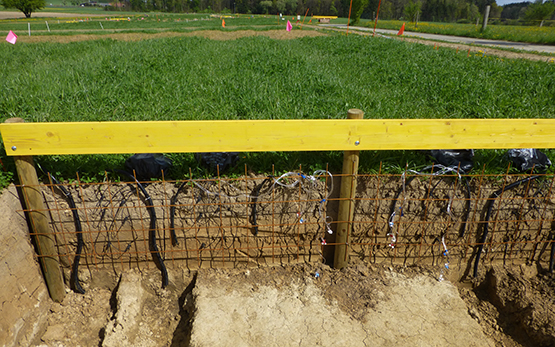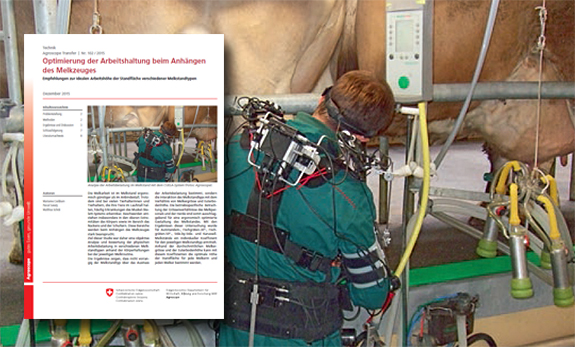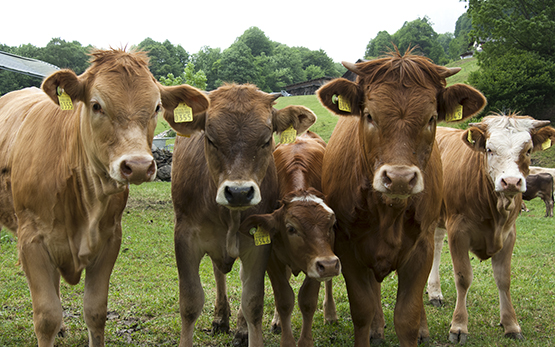Sato Y., Wüst S.
The genetics of plant - plant interactions and their cascading effects on agroecosystems: From model plants to applications.
Plant & Cell Physiology, In Press, 2024, Articolo pcae092.
Wettstein G., Wullschleger G., Melgar A., Schnée S., Gindro K., Patocchi A., Wüst S.
Identifying recessive resistances against powdery and downy mildew in the domesticated grapevine.
In: 7th International Conference of Quantitative Genetics. 22 Juli, Ed. ISTA, Wien (AT). 2024.
Xu W., Thieme M., Roulin A.
Natural diversity of heat-induced transcription of retrotransposons in Arabidopsis thaliana.
Genome Biology and Evolution, 16, (11), 2024, 1-16.
Greenwood J. R., Lacorte-Apostol V., Kroj T., Padilla J., Telebanco-Yanoria M. J., Glaus A. N., Roulin A., Padilla A., Zhou B., Keller B., Krattinger S. G.
Genome-wide association analysis uncovers rice blast resistance alleles of Ptr and Pia.
Communications Biology, 7, 2024, Articolo 607.
Katouzi M., Kellenberger R., Bucher E.
Impact of genotoxic stress on extrachromosomal circular DNA (eccDNA) in rice (Oryza sativa).
In: 11th Plant Genomics and Gene Editing Congress. 22 October, Ed. Global Engage, Raleigh, NC (USA). 2024.
Brunner S., Weichert H., Meissle M., Romeis J., Weber H.
Field trials reveal trade-offs between grain size and grain number in wheat ectopically expressing a barley sucrose transporter.
Field Crops Research, 316, 2024, 1-12.
Li Z., Gilbert C., Peng H., Pollet N.
Discovery of numerous novel Helitron-like elements in eukaryote genomes using HELIANO.
Nucleic Acids Research, 52, (17), 2024, Articolo e79.
Lopez M., Denoyes B., Bucher E.
Epigenomic and transcriptomic persistence of heat stress memory in strawberry (Fragaria vesca).
BMC Plant Biology, 24, (405), 2024, 1-17.
Camenzind M., Koller T., Armbruster C.-S., Jung E., Brunner S., Herren G., Keller B.
Breeding for durable resistance against biotrophic fungal pathogens using transgenes from wheat.
Molecular Breeding, 44, (8), 2024, 1-22.
Koller T., Camenzind M., Jung E., Brunner S., Herren G., Armbruster C., Keller B.
Pyramiding of transgenic immune receptors from primary and tertiary wheat gene pools improves powdery mildew resistance in the field.
Journal of Experimental Botany, 75, (7), 2024, 1872-1886.
Tschurr F., Oppliger C., Wüst S., Kirchgessner N., Walter A.
Mixing things up! Identifying early diversity benefits and facilitating the development of improved variety mixtures with high throughput field phenotyping.
The Plant Phenome Journal, 6, (1), 2023, 1-12.
Montazeaud G., Helleu Q., Wüst S., Keller L.
Indirect genetic effects are shaped by demographic history and ecology in Arabidopsis thaliana.
Nature Ecology & Evolution, 7, 2023, 1878-1891.
Latzel V., Puy J., Thieme M., Bucher E., Götzenberger L., de Bello F.
Phenotypic diversity influenced by a transposable element increases productivity and resistance to competitors in plant populations.
Journal of Ecology, 111, (11), 2023, 2376-2387.
Kopp E., Niklaus P. A., Wüst S.
Ecological principles to guide the development of crop variety mixtures.
Journal of Plant Ecology, 16, (6), 2023, 1-15.
Akbari M., Sabouri H., Sajadi S. J., Yarahmadi S., Ahangar L., Abedi A., Katouzi M.
Mega Meta-QTLs: A strategy for the production of Golden Barley (Hordeum vulgare L.) tolerant to abiotic stresses.
Genes, 13, (11), 2023, 1-28.
Jung M., Bühlmann-Schütz S., Hodel M., Kellerhals M., Bolliger N., Köhle M., Kobelt M., Muranty H., Studer B., Broggini G., Patocchi A.
Approaches to implement genomic selection in three Swiss apple breeding programs.
In: XXXI International Horticultural Congress (IHC2022): International Symposium on Breeding and Effective Use of Biotechnology and Molecular Tools in Horticultural Crops. 1362, Ed. ISHS Acta Horticulturae. 2023, 131-138.
Muranty M., Jung M., Roth M., Cazenave X., Patocchi A., Laurens F., Durel C.-E.
Genomic selection in apple: Lessons from preliminary studies.
In: XXXI International Horticultural Congress (IHC2022): International Symposium on Breeding and Effective Use of Biotechnology and Molecular Tools in Horticultural Crops. 1362, Ed. ISHS Acta Horticulturae. 2023, 113-122.
Domenichini C., Negri P., Defrancesco M., Alessandri S., Bergonzoni L., Verde I., Malnoy M., Broggini G., Patocchi A., Peil A., Emeriewen F., Dondini L., Tartarini S.
New breeding technology approaches to improve apple and pear cultivars.
In: XXXI International Horticultural Congress (IHC2022): International Symposium on Breeding and Effective Use of Biotechnology and Molecular Tools in Horticultural Crops. 1362, Ed. ISHS Acta Horticulturae. 2023, 199-204.
Schlathölter I., Studer B. , Patocchi A., Broggini G.
No unintended changes in the proteome and metabolome of the cisgenic fire blight resistant apple line C44.4.146.
In: XXXI International Horticultural Congress (IHC2022): International Symposium on Breeding and Effective Use of Biotechnology and Molecular Tools in Horticultural Crops. 1362, Ed. ISHS Acta Horticulturae. 2023, 9-14.
Schlathölter I., Broggini G., Studer B., Meissle M., Romeis J., Patocchi A.
Field investigation of consequences from the genetic modification resulting in the fire blight resistant cisgenic apple line C44.4.146.
In: XXXI International Horticultural Congress (IHC2022): International Symposium on Breeding and Effective Use of Biotechnology and Molecular Tools in Horticultural Crops. Ed. ISHS Acta Horticulturae. 2023, 1-8.
Wüst S., Schulz L., Rana S., Frommelt J., Ehmig M., Pires N., Grossniklaus U., Hardtke C., Hammes U., Schmid B., Niklaus P.
Single-gene resolution of diversity-driven overyielding in plant genotype mixtures.
Nature Communications, 14, 2023, 1-11.
Schlathölter I., Broggini G., Streb S., Studer B., Patocchi A.
Field study of the fire-blight-resistant cisgenic apple line C44.4.146.
The Plant Journal, 113, (6), 2023, 1160-1175.
Kümin M., Oeschger F., Bearth A., Reinhardt D., Romeis J., Soyk S., Studer B.
Neue Züchtungstechnologien: Anwendungsbeispiele aus der Pflanzenforschung.
Swiss Academies Communications, 18, (2), 2023, 1-16.
altre lingue:
francese
Makhtoum S., Sabouri H., Gholizadeh A., Ahangar L., Katouzi M., Mastinu A.
Mapping of QTLs controlling barley agronomic traits (Hordeum vulgare L.) under normal conditions and drought and salinity stress at reproductive stage.
Plant Gene, 31, 2022, 1-23.
Makhtoum S., Sabouri H., Gholizadeh A., Ahangar L., Katouzi M.
QTLs controlling physiological and morphological traits of barley (Hordeum vulgare L.) seedlings under salinity, drought, and normal conditions.
BioTech, 11, (3), 2022, 1-20.
Krynytskyy H., Gout R., Kovaleva V., Hrunyk N.
Дослідження генетичного різноманіття видового складу лісових деревостанів = Investigation of the genetic diversity of species composition of forest stands.
Proceedings of the Forestry Academy of Sciences of Ukraine, 24, 2022, 11-23.
Peter R.
Wie Agroscope die neuen Züchtungstechnologien einschätzt: Kommentar von Roland Peter.
Obst- und Weinbau, 158, (5), 2022, 7.
Wüst S., Pires N.D., Luo S., Vasseur F., Messier J., Grossniklaus U., Niklaus P.
Increasing plant group productivity through latent genetic variation for cooperation.
PLOS Biology, 20, (20), 2022, e3001842.
Schlathölter I., Broggini G., Meissle M., Romeis J., Studer B., Patocchi A.
Multi-level assessment of field-grown cisgenic apple trees.
In: Proceedings of the XV EUCARPIA Symposium on Fruit Breeding and Genetics. 1307, Ed. ISHS, Acta Horticulturae. 2022, 239-246.
Patocchi A., Wehrli A., Dubuis P.-H., Auwerkerken A., Leida A., Cipriani G., Passey T., Staples M., Didelot F., Philion V., Peil A., Laszakovits H., Rühmer T., Boeck K., Baniulis D. e altri
Ten years of VINQUEST: First findings.
In: Proceedings of the XV EUCARPIA Symposium on Fruit Breeding and Genetics. 1307, Ed. ISHS, Acta Horticulturae. 2022, 315-320.
Jung M., Keller B., Roth M., Aranzana M.J., Auwerkerken A., Guerra W., Al-Rifaï M., Lewandowski M., Sanin N., Rymenants M., Didelot F., Dujak C., Font i Forcada C., Knauf A., Laurens F. e altri
Genetic architecture and genomic predictive ability of apple quantitative traits across environments.
Horticulture Research, 9, 2022, Articolo uhac028.
Lieberman-Lazarovich M., Kaiserli E., Bucher E., Mladenov V.
Natural and induced epigenetic variation for crop improvement.
Current Opinion in Plant Biology, 70, 2022, Articolo 102297.
Lopez Ortiz M. E., Roquis D., Becker C., Denoyes B., Bucher E.
DNA methylation dynamics during stress response in woodland strawberry (Fragaria vesca).
Horticulture Research, online, (4 August), 2022, 1-32.
Peng H., Marie Mirouze, Bucher E.
Extrachromosomal circular DNA: A neglected nucleic acid molecule in plants.
Current Opinion in Plant Biology, 69, 2022, 1-9.
Thieme, M., Brêchet, A., Bourgeois, Y., Keller, B., Bucher E., Roulin, A.C.
Experimentally heat-induced transposition increases drought tolerance in Arabidopsis thaliana.
New Phytologist, 236, (1), 2022, 182-194.
Schlathölter I., Meissle M., Boeriis T., Heimo D., Studer B., Broggini G., Romeis J., Patocchi A.
No adverse dietary effect of a cisgenic fire blight resistant apple line on the non-target arthropods Drosophila melanogaster and Folsomia candida.
Ecotoxicology and Environmental Safety, 241, 2022, 1-9.
Makhtoum S., Sabouri H., Gholizadeh A., Ahangar L., Taliei F., Katouzi M.
Important chromosomal regions for genetic control of powderymildew resistance under control, drought, and saline conditionsin barley (Hordeum vulgare L.).
Tropical Plant Pathology, 46, 2021, 622-642.
Sabouri H., Gholizadeh A., Alegh S. M., Sanchouli S., Katouzi M.
Genetic structure of Fe toxicity tolerance in Iranian rice (Oryza sativa L.) inbred lines population at seedling stage.
Journal of Plant Molecular Breeding, 9, (2), 2021, 12-23.









